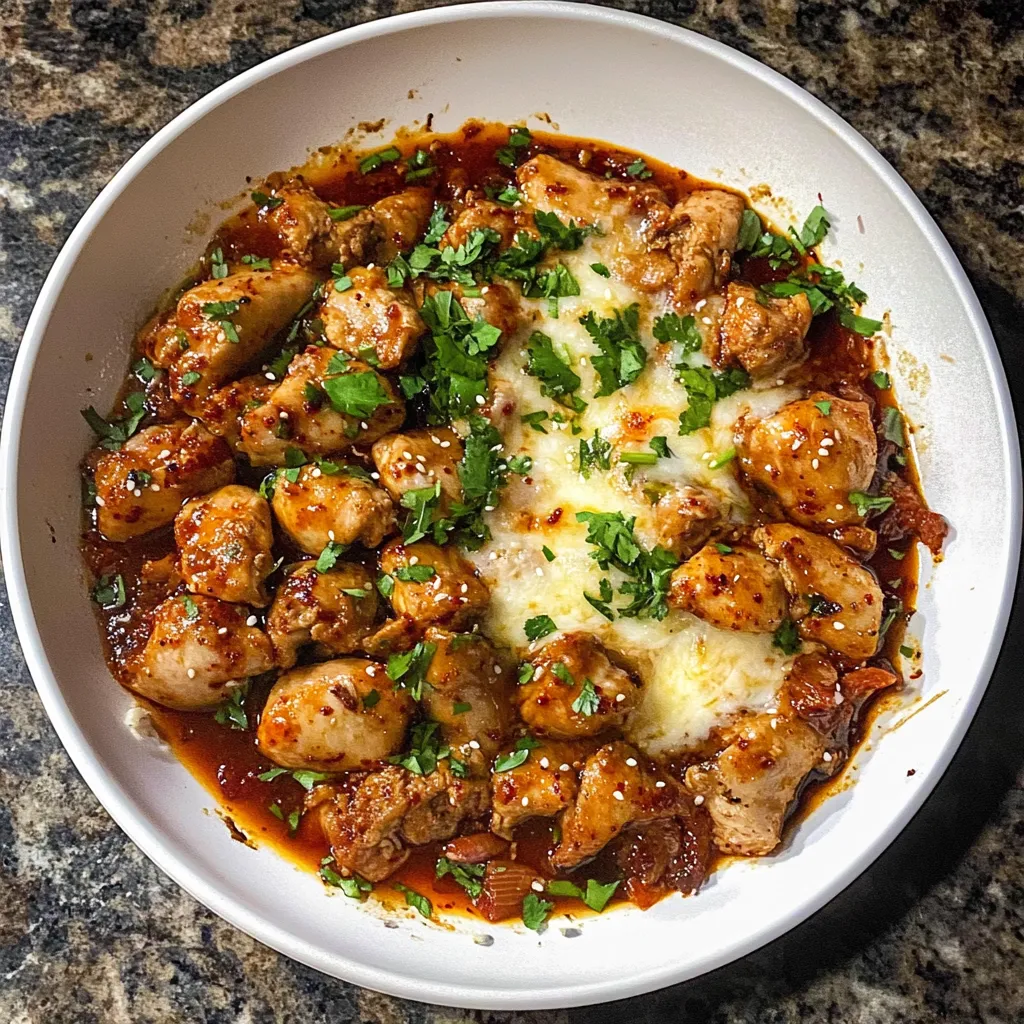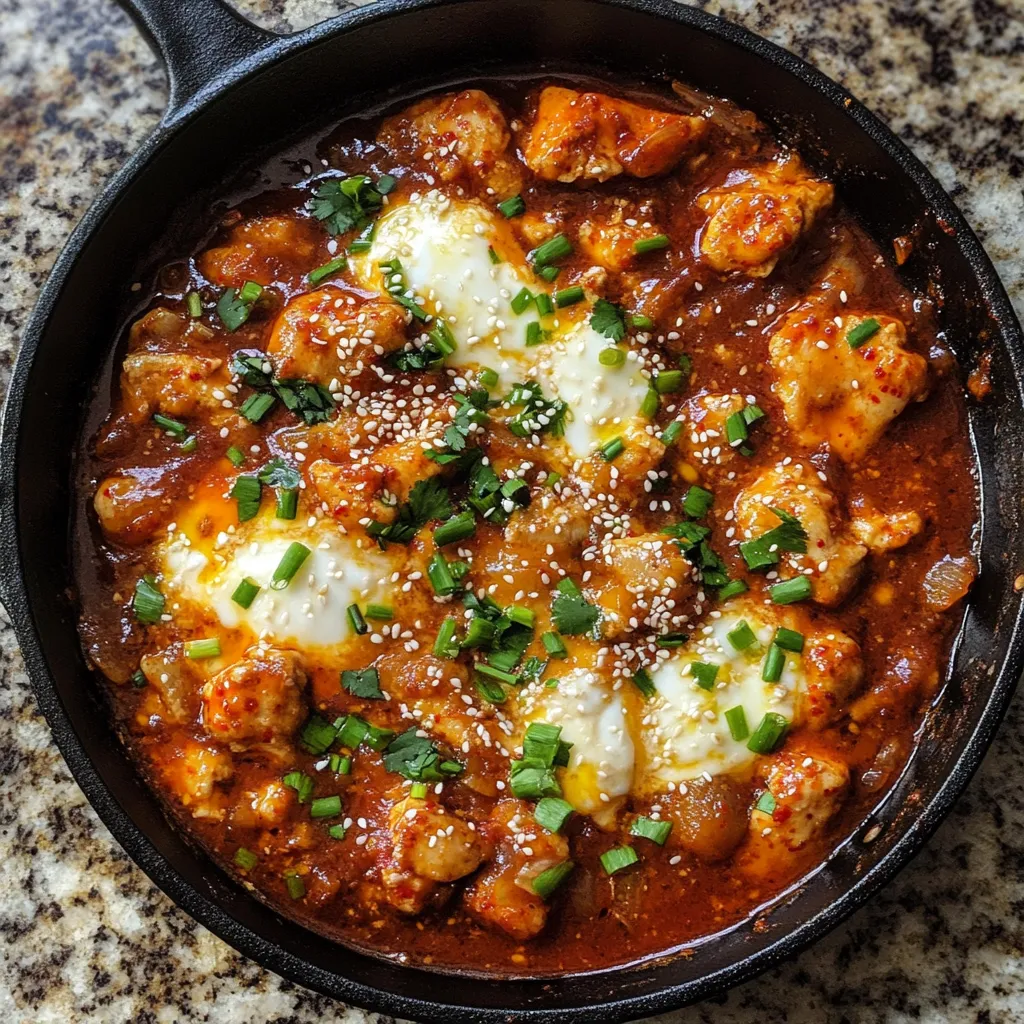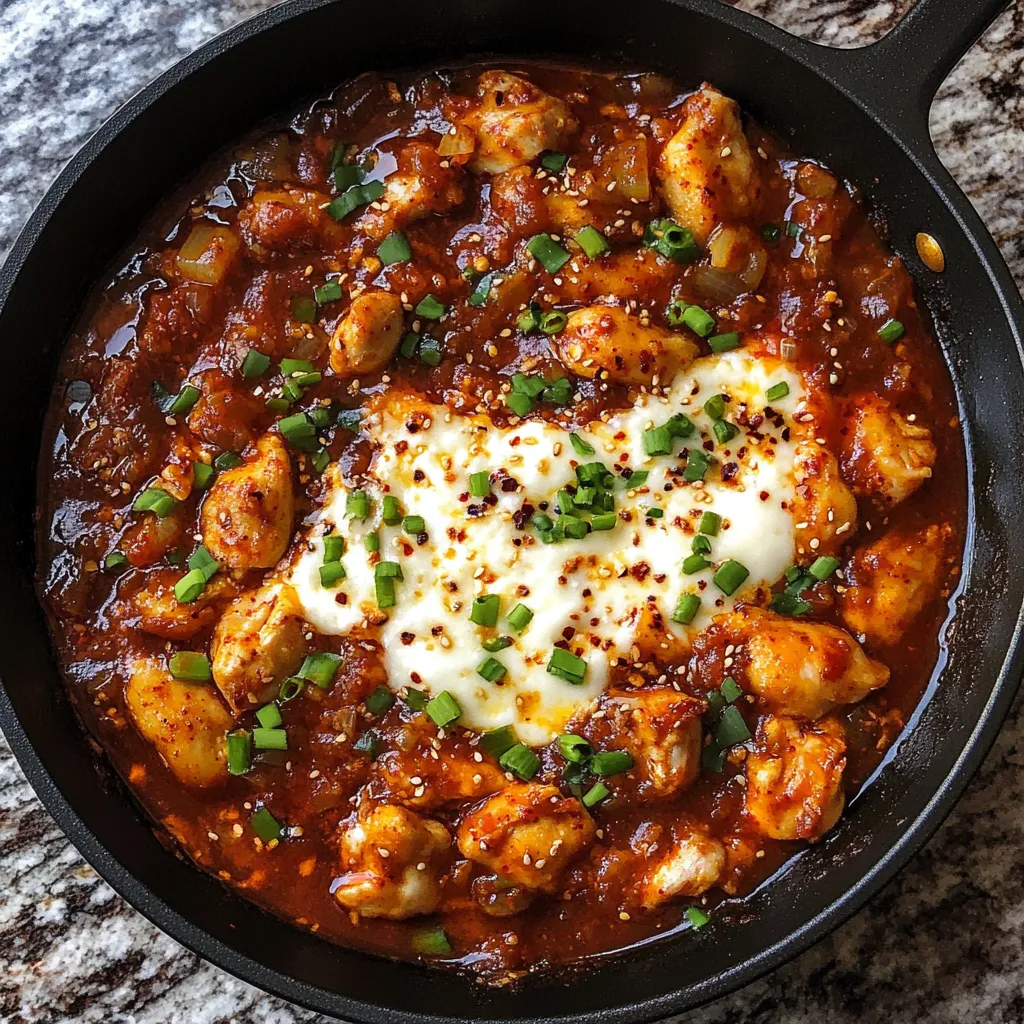 Pin it
Pin it
Fiery red chicken glistening with a glossy chili sauce delivers powerful flavor that ignites the senses with each succulent bite. This authentic Korean buldak transforms humble chicken into an addictive dish that balances intense heat with subtle sweetness and umami depth. The combination of gochujang and gochugaru creates that distinctive Korean spice profile that food enthusiasts around the world have fallen in love with. When finished with a blanket of bubbling cheese that stretches dramatically with each forkful, this dish delivers a sensory experience that explains why it has become a global street food sensation. Perfect for spice lovers seeking bold flavors, this homemade version rivals any restaurant offering.
I first encountered buldak during a late night food exploration in Seoul's vibrant Myeongdong district. What struck me most was how the vendor carefully caramelized the edges of the chicken before adding additional sauce, creating textural contrast that elevated the dish beyond simple spicy chicken. After returning home, I spent months perfecting this recipe, discovering that allowing the chicken to marinate overnight creates significantly more flavorful results that truly capture the essence of authentic Korean street food.
Essential Ingredients
- Chicken thighs: Choose boneless skinless thighs rather than breast meat as they remain tender even when cooked through completely, their higher fat content creating juicier bites that stand up beautifully to the intense sauce.
- Gochujang: This fermented Korean chili paste contributes complex sweet, savory, and spicy elements that form the foundation of the sauce, with its glutinous rice base providing natural thickening properties.
- Gochugaru: These coarsely ground Korean chili flakes offer vibrant color and layered heat without overwhelming bitterness, creating depth impossible to achieve with standard cayenne or red pepper flakes.
- Rice syrup: This traditional Korean sweetener balances the heat with subtle sweetness and adds glossy texture to the sauce, though honey can substitute while maintaining similar consistency.
- Sesame oil: Just a small amount adds distinctive nutty aroma that signals authentic Korean flavors while helping the sauce cling beautifully to each piece of chicken.
- Fresh garlic and ginger: These aromatic ingredients are non negotiable for building the foundational flavor profile, with freshly minced versions dramatically outperforming pre prepared alternatives.
- Mozzarella cheese: The mild, melty nature of this cheese provides cooling contrast to the spicy chicken without competing with its complex flavors, becoming wonderfully stretchy when melted.
Perfect Preparation
- Sauce building:
- Combine gochugaru, gochujang, soy sauce, oils, sweetener, and aromatics in a bowl large enough for thorough mixing, whisking until completely homogeneous to ensure consistent flavor distribution throughout the chicken.
- Proper marinating:
- Cut chicken thighs into uniform bite sized pieces approximately 1.5 inches square before adding to the sauce, massaging thoroughly to ensure complete coverage and allowing at least one hour for flavors to penetrate.
- Patient cooking:
- Heat a heavy cast iron skillet over medium heat rather than high to prevent burning the sugars in the sauce, adding chicken with its marinade in a single layer without overcrowding.
- Managed moisture:
- Add just enough stock or water to create steam without diluting flavors, maintaining a gentle simmer that allows chicken to cook through while sauce reduces to intensely flavorful glaze.
- Perfect melting:
- Position oven rack 6 inches from broiler element and preheat before adding cheese to ensure quick, even melting with slight browning that creates irresistible texture without overcooking the chicken beneath.
- Thoughtful garnishing:
- Sprinkle green onions, sesame seeds, and additional chili flakes immediately before serving for contrasting colors, fresh flavors, and textural variety that elevate the finished presentation.
 Pin it
Pin it
My Korean grandmother always insisted that proper buldak requires patience during the reduction stage. She taught me to never rush this critical process, explaining that allowing the sauce to slowly caramelize around the edges of the pan creates complex flavor notes impossible to achieve otherwise. This wisdom transformed my cooking, not just for this dish but for any recipe requiring reduction. The difference between merely spicy chicken and transcendent buldak lies in this patient approach to cooking, allowing sugars to caramelize and flavors to concentrate gradually.
Sensational Serving
Create an authentic Korean dining experience by serving this fiery chicken with complementary side dishes that balance and enhance its bold flavors. Offer small dishes of simple cucumber kimchi that provides cooling crunch between bites of spicy chicken. Include steamed white rice that tempers the heat while soaking up the delicious sauce. Complete the meal with light, refreshing dongchimi (radish water kimchi) that cleanses the palate with its subtle tartness. For an impressive presentation, serve the bubbling hot skillet at the table on a wooden board with small individual plates for sharing, encouraging the communal dining experience central to Korean food culture.
Chef Insights
- Toast whole sesame seeds in a dry pan until fragrant before grinding and adding to the sauce for significantly enhanced nuttiness.
- Create caramelized edges by allowing chicken to cook undisturbed for the first few minutes of cooking rather than constantly stirring.
- Balance the intense heat with small amounts of vinegar added just before serving to brighten flavors and add complexity.
 Pin it
Pin it
This Korean fire chicken represents everything wonderful about global street food traditions adapted for home cooking. The complex interplay between fierce spiciness, subtle sweetness, and savory depth creates an experience that transcends simple heat, engaging all taste receptors in perfect harmony. What makes this dish particularly special is how it transforms affordable ingredients into something truly extraordinary through thoughtful technique and balanced seasoning. The dramatic presentation with its bubbling cheese topping never fails to impress guests, while the deeply satisfying flavors create memorable dining experiences that leave everyone asking for the recipe.
Frequently Asked Questions
- → What are gochujang and gochugaru, and where can I find them?
- Gochujang is a fermented Korean chili paste that's sweet, savory, and spicy, while gochugaru are Korean chili flakes. You can find both in Asian grocery stores, the international aisle of well-stocked supermarkets, or online. If you're in a pinch, you could substitute sriracha mixed with a bit of miso paste for gochujang, and regular crushed red pepper flakes for gochugaru, though the flavor won't be quite the same.
- → Can I make this dish less spicy?
- Absolutely! To reduce the heat, start by using half the amount of gochugaru (Korean chili flakes) and use mild gochujang instead of hot. You can also skip the fresh chili peppers entirely. The cheese topping helps balance the heat as well. Taste the marinade before adding the chicken and adjust to your preference.
- → Is it necessary to marinate the chicken for the full hour?
- While marinating for at least an hour helps the flavors penetrate the meat, you can reduce the time to 30 minutes if you're in a hurry. For the best flavor, try to marinate for the full hour or even overnight. If you're really pressed for time, you can cook it immediately after mixing, but the flavor won't be as developed.
- → Can I make this dish without the cheese topping?
- Yes! Traditional buldak doesn't actually include cheese - that's a modern addition that has become popular. The dish is still delicious without it. If you skip the cheese, you can also skip the broiling step and simply finish cooking on the stovetop.
- → What sides go well with Korean fire chicken?
- White rice is the classic accompaniment to help balance the heat. Kimchi, pickled radishes, or cucumber salad also work well for contrast. For a low-carb option, serve with lettuce leaves for wrapping. Some people enjoy adding sliced rice cakes (tteok) to the dish while cooking for an authentic Korean street food experience.
